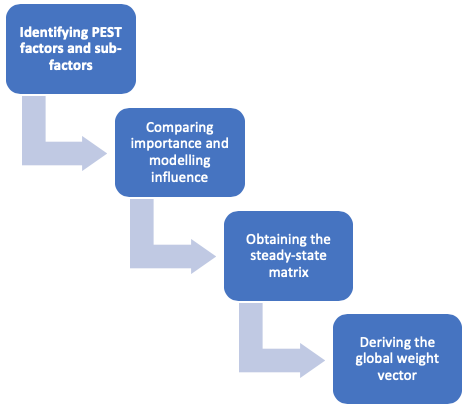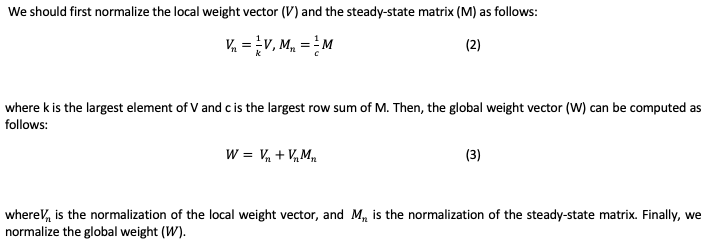

Vol. 40 (Number 3) Year 2019. Page 23
Sol David LOPEZDOMÍNGUEZ Rivas 1; Maikel LEVYA 2
Received: 31/08/2018 • Approved: 20/12/2018 • Published 28/01/2019
ABSTRACT: Currently PEST analysis provides mainly a general idea about the macro environmental conditions and situation of a company or project. In this paper, a new model for PEST analysis is presented based on fuzzy decision maps for food industry. The proposed framework is composed of four activities obtaining a ranking of factors. A case study of how the food industry is affected by political, economic, social and technological factors is presented. Further works will concentrate on developing a software tool. |
RESUMEN: Actualmente el marco de trabajo del análisis PEST solo provee una idea general de las condiciones macro-ambientales de un compañía o proyecto. En el presente trabajo se propone un nuevo modelo para el análisis PEST basado en los mapas de decisión difusos para la industria alimenticia. Se desarrolla un estudio de caso basado en cómo esta industria es afectada por factores políticos económicos sociales y tecnológicos es presentado. Trabajos futuros se centrarán el desarrollo de una herramienta informática. |
The PEST (Political, Economic, Social and Technological) framework, is used to assess these four external factors in relation to a business situation (Healey, 1994). Environment and legal factors could be included and then is named PESTEL (Political, Economic, Socio-cultural, Technological, Environment and Legal) analysis (Yüksel, 2012).
PEST analysis lacks a quantitative approach to the measurement of interrelation among its factors (Yüksel, 2012). Standard technical framework of PEST does not adequately support that approach .A new approach based on fuzzy decision maps is presented in (VÁZQUEZ, HERNÁNDEZ, HERNÁNDEZ, SALVATIERRA, & BARYOLO, 2018).
In this paper a model for PEST analysis based fuzzy decision maps (FDM)(Yu & Tzeng, 2006) is presented giving methodological support and the possibility of dealing with interdependence, and feedback for the food industry. This work is structured as follows: Section 1.1 and 1.2 reviews some important concepts about PEST analysis framework and fuzzy cognitive maps(FCM), respectively. In Section 2, a framework for PEST analysis based on FDM for the food industry }composed of five activities, identifying PEST factors and sub-factors, compare importance, modelling influence, obtaining the steady-state matrix and derive the global weight vector is presented. Section 3 shows a case study of the proposed model is presented. The paper ends with conclusions and further work recommendations.
PEST (Political, Economic, Social and Technological), analysis is a precondition analysis with the mains function of the identification of the environment within which the company operates and providing data and information that will enable the organization to make predictions about new situations and circumstances (Frynas & Mellahi, 2015; Thompson & Martin, 2010). Factors in PEST analyzed are generally measured and evaluated independently (Yüksel, 2012). In (Yüksel, 2012) a proposal for PEST analysis in a multicriteria environment is presented but lacks interrelation analysis.
In (VÁZQUEZ et al., 2018) a new approach based on fuzzy decision maps is presented taking into account interdependency among general factor is taken into account. Additionally, factors and sub-factor have ambiguity, vagueness in their interrelations
This study presents a model to address problems encountered in the measurement and evaluation process of PEST analysis in food industry considering interdependencies among sub-factors. The structure of PEST sub-factors was modeled by FCM and a quantitative analysis is developed based on the FDM method.
Axelrod (Axelrod, 2015) introduce cognitive maps were introduced by where nodes represent concept or variables in a domain and arcs indicate positive or negative causal relations. Kosko extends cognitive maps with fuzzy logics as fuzzy cognitive maps (FCM)(Kosko, 1986) (Figure 1) . FCM are fuzzy graph for representing causal knowledge, extending cognitive maps with fuzzy values in the [-1,1] interval indicating the strength of causal relations.
The matrix representation of FCM allows causal inferences. there are three possible types of causal relations between nodes represented in the matrix: negative, positive and no relationship (Leyva-Vázquez, Santos-Baquerizo, Peña-González, Cevallos-Torres, & Guijarro-Rodríguez, 2016).
Figure 1
Example of FCM and adjacency matrix

(Maikel Leyva-Vázquez, Karina Pérez-Teruel,
Ailyn Febles-Estrada, & Jorge Gulín-González, 2013).
FCM have been applied diverse areas such as decision support and causality analysis (MY Leyva-Vázquez, KY PÉREZ-TERUEL, Ailyn Febles-Estrada, & Jorge Gulín-González, 2013). Fuzzy decision map (FDM) were proposed in 2006 for solving the multicriteria decision making problem taking into account dependence and feedback (Yu & Tzeng, 2006). For overcoming the shortcoming in the AHP and ANP methods. FDM incorporates the eigenvalue method, FCM, and the weighting equation (Elomda et al., 2013).
The advantages of FDM (Elomda, Hefny, & Hassan, 2013; Tzeng, Chen, Yu, & Shih, 2010) overcome the drawbacks of the AHP and ANP, employing the different threshold functions to indicate the various kinds of relationship among criteria. The ability to solve both the compound and the interaction effects and dealing with direct and indirect influences are another area of advantage.
Our aim in the proposal is developing a framework for PEST analysis based on FDM for food industry. The model consists of the following phases (graphically, Figure 2).
Figure 2
Proposed framework for PEST analysis

In this step, the relevant PEST factors and sub-factors are identified in food industry. PEST factors are derived from the themes: political, economic, socio-cultural, technological factors. Identifying PEST factors and sub-factors allowing to form a hierarchical structure of the model.
The importance among nodes is compared to derive the local weight vector using the eigenvalue approach (Elomda et al., 2013) . This should be done by domain experts according to the preference scale shown in table1.
Table 1
Scale for relationship among criteria
Description |
Numerical Value |
Equal importance |
1 |
Moderate importance |
2 |
Strong importance |
3 |
Very strong importance |
4 |
Extreme importance |
5 |
Fuzzy cognitive map to indicate the influence among criteria by the expert is developed. Causal interdependencies among PEST sub-factors are modelled this way. This step consists of the formation of FCM of sub-factors, as nodes according to experts.


PEST analysis identifies external factors which influence a specific business. In this case, we’re examining how the food industry could be affected by political, economic, social and technological factors.
Public health policies are pushing the food industry to produces with lower sodium and sugar. Additionally, current policies push for the public to be more conscious when buying foods. Political factor identified include environmental regulations, and evolving health policies.
Economics factor of a country like unemployment rates can affect the food industry. Healthier alternatives to foods are more expensive to buy compared to fast food or easy-to-make meals. Economic factor identified are taxation, and consumer spending .
Food industry is not only pushed by governmental authorities, but by consumers, as well. Social factors identified are lifestyle changes and awareness of citizen about ecological issues.
Technology can give a competitive edge. In food industry Technology is necessary to create packaging, food labels, and the production of food and for reaching consumers in new and easier methods. As technological factor identified are online presence and technological access.
Figure 3 shows the hierarchical structure.
Figure 3
The hierarchical model of PEST in the vertical farming project.

For choosing the best alternative, we should derive the influence scores of each criterion and calculate the influence scores of each factor.
The Scoring matrix (E) was elicited as follows:
From the matrix above, we can calculate the local weights by means of the eigenvalue method (Table 2).
Table 2
Local Weights
|
Local Weights |
P1 |
0.12674983 |
P2 |
0.24620347 |
E1 |
0.08644919 |
E2 |
0.5241169 |
S1 |
0.19905528 |
S2 |
0.18926886 |
T1 |
0.24261768 |
T2 |
0.38553879 |
Interdependencies among nodes are identified and modelled by means of a FCM. using the Mental Modeler Tool(Gray, Gray, Cox, & Henly-Shepard, 2013).
Figure 4
Fuzzy Cognitive Map

Adjacency matrix of the FCM is shown in Figure 5.
Figure 5
Adjacency matrix

Using the pure-linear the steady-state matrices. Finally, using Eq. (3), we can obtain the global weights as shown in Table 3.
Table 3
Global weights
|
Local Weights |
P1 |
0.02705181 |
P2 |
0.13684334 |
E1 |
0.01808746 |
E2 |
0.27804667 |
S1 |
0.1670944 |
S2 |
0.07817771 |
T1 |
0.15657394 |
T2 |
0.22840322 |
The ranking obtained is as follows:
Consumer spending was selected as the top environment factor. After application in this case study the model is found to be practical to use giving high flexibility and considering interdependencies within PEST analysis for food industry.
Food industry is affected by political, economic, social and technological factors. This study presents a model to address problems encountered in the measurement and evaluation process of PEST analysis considering interdependencies among sub-factors and modeling uncertainty for the food industry. The integrated structure of PEST sub-factors was modeled by FCM.
To demonstrate the applicability of the proposal a case study is presented. Most notably, this is the first study to our knowledge to integrate FDM to the PEST analysis Schema for food industry. Further works will concentrate in extending the model for dealing scenario analysis. Another area of future is the development of a software tool.
Axelrod, R. (2015). Structure of decision: The cognitive maps of political elites: Princeton university press.
Elomda, B. M., Hefny, H. A., & Hassan, H. A. (2013). An extension of fuzzy decision maps for multi-criteria decision-making. Egyptian Informatics Journal, 14(2), 147-155. doi: http://dx.doi.org/10.1016/j.eij.2013.05.001
Frynas, J. G., & Mellahi, K. (2015). Global strategic management: Oxford University Press, USA.
Gray, S. A., Gray, S., Cox, L. J., & Henly-Shepard, S. (2013). Mental modeler: a fuzzy-logic cognitive mapping modeling tool for adaptive environmental management. Paper presented at the System Sciences (HICSS), 2013 46th Hawaii International Conference on.
Healey, N. M. (1994). The transition economic of central and eastern Europe: A political, economic, social and technological analysis. The Columbia Journal of World Business, 29(1), 62-70.
Kosko, B. (1986). Fuzzy cognitive maps. International Journal of man-machine studies, 24(1), 65-75.
Leyva-Vázquez, M., PÉREZ-TERUEL, K., Febles-Estrada, A., & Gulín-González, J. (2013). Modelo para el análisis de escenarios basados en mapas cognitivos difusos: estudio de caso en software biomédico. Ingenieria y Universidad, 17(2), 375-390.
Leyva-Vázquez, M., Pérez-Teruel, K., Febles-Estrada, A., & Gulín-González, J. (2013). Técnicas para la representación del conocimiento causal: un estudio de caso en Informática Médica. Revista Cubana de información en ciencias de la salud, 24(1), 73-83.
Leyva-Vázquez, M., Santos-Baquerizo, E., Peña-González, M., Cevallos-Torres, L., & Guijarro-Rodríguez, A. (2016). The Extended Hierarchical Linguistic Model in Fuzzy Cognitive Maps. Paper presented at the Technologies and Innovation: Second International Conference, CITI 2016, Guayaquil, Ecuador, November 23-25, 2016, Proceedings 2.
Thompson, J. L., & Martin, F. (2010). Strategic management: awareness & change: Cengage Learning EMEA.
Tzeng, G.-H., Chen, W.-H., Yu, R., & Shih, M.-L. (2010). Fuzzy decision maps: a generalization of the DEMATEL methods. Soft Computing, 14(11), 1141-1150. doi: 10.1007/s00500-009-0507-0
VÁZQUEZ, M. L., HERNÁNDEZ, J. H., HERNÁNDEZ, N. B., SALVATIERRA, J. A. A., & BARYOLO, O. G. (2018). A framework for PEST analysis based on fuzzy decision maps. Espacios, 39(13).
Yu, R., & Tzeng, G.-H. (2006). A soft computing method for multi-criteria decision making with dependence and feedback. Applied Mathematics and Computation, 180(1), 63-75.
Yüksel, I. (2012). Developing a multi-criteria decision making model for PESTEL analysis. International Journal of Business and Management, 7(24), 52-66.
1. Universidad de Guayaquil. Facultad de Ciencias Administrativas. Carrera de Contaduría Pública Autorizada. Email: sol.lopezdominguezr@ug.edu.ec
2. Universidad de Guayaquil. Facultad de Ciencias Matemáticas y Físicas. Carrera de Ingeniería en Sistema